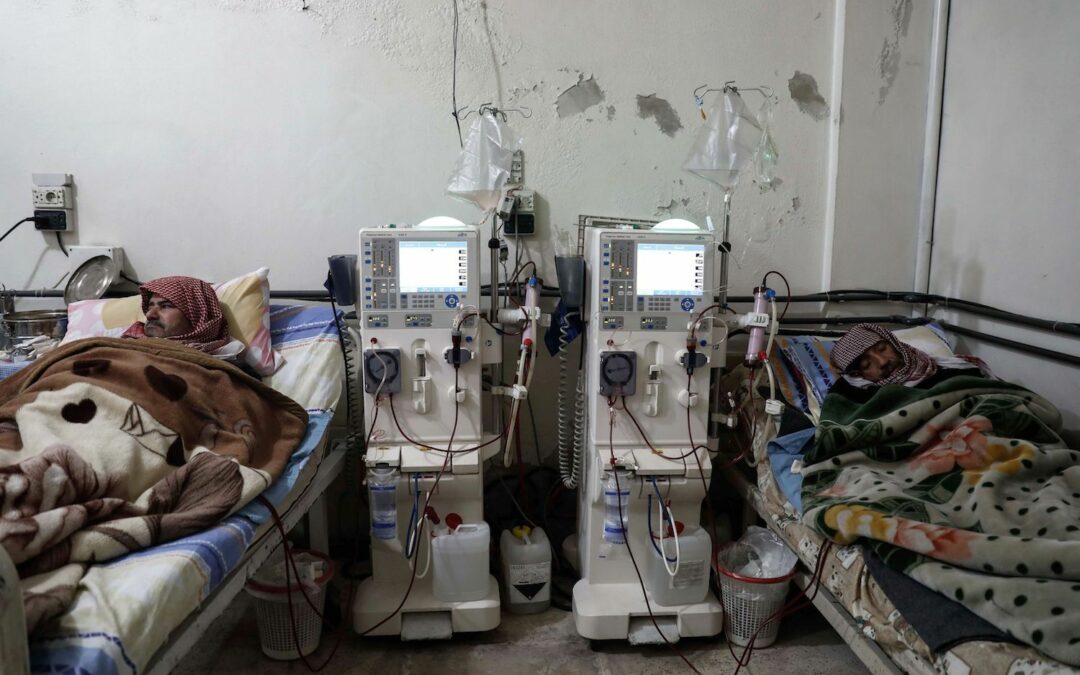Syrian patients receiving treatment in a basement-turned-clinic in the besieged rebel-held town of Douma, on the outskirts of Damascus, on March 16, 2017. (SAMEER AL-DOUMY/AFP/GETTY IMAGES)
Article initially published by Foreign Policy on October 24, 2018 and written by Annie Sparrow
Biological warfare is generally understood as the deliberate wartime introduction of a lethal pathogen with the intent to kill or maim. Syria under President Bashar al-Assad is pursuing a sinister variation – one with long and dangerous historical precedents. Assad’s government has allowed pathogens normally controlled by public health measures – such as clean water, sanitation, waste disposal, vaccination, and infection control – to emerge as biological weapons through the deliberate destruction and withholding of those measures. The conflict has in effect reversed public heath advances to achieve levels of disease not seen since the Napoleonic era.
Warfare was long synonymous with conditions preferred by germs—soldiers were packed into trenches without sanitation or clean water, exposed to the environment, and surrounded by vermin. Poor nutrition didn’t help, and penicillin wasn’t an option until the 1940s. During the Napoleonic wars, eight times more British soldiers died from pneumonia, typhoid, and dysentery than in battle. In the American Civil War, two-thirds of all deaths were due to pneumonia, diarrheal disease, and malaria.
World War I was the first war in which combat caused more deaths than disease. (The Spanish influenza epidemic struck toward the end of the war and is not included in these figures.) Florence Nightingale had already revolutionized hospital hygiene practices during the Crimean war of the 1850s, reducing death rates from hospital-acquired infection from 40 percent to 2 percent. But during World War I, the penetrating wounds caused by machine guns were quickly contaminated, and the only way to control the resulting gas gangrene was amputation. That drove the development of powerful wound disinfectants.
After 1941, penicillin reduced post-operative pneumonia death rates from more than 30 percent to less than 10 percent, and surgical infections dropped to about 5 percent. During the Iraq War, more U.S. soldiers died from suicide than infectious disease. These days, mass displacement and the resulting crowded refugee camps mean that it is now mainly civilians who suffer the infectious consequences of conflict.
Biological warfare goes back two millennia. Assyrians poisoned enemy water sources in the 6th century B.C. In 1346, Tartars catapulted bodies of plague victims over the city walls of Caffa in Crimea to break the siege—and potentially kick-started a second plague pandemic. In 1650, Polish forces shot their enemies with saliva from rabid dogs. In Italy, Napoleon flooded Mantua’s plains in an effort to spread malaria. In the United States, Confederate sympathizers allegedly sold clothing from patients with yellow fever and smallpox to Union troops. Often inadvertently but sometimes deliberately, European settlers spread smallpox with devastating effect among the indigenous American population.
During World War I, Germany unsuccessfully tried out anthrax. During World War II, Japan used prisoners of war as guinea pigs for experiments with gas gangrene, anthrax, cholera, dysentery, and plague, killing at least 3,000 people. In the field, Japanese troops sprayed plague-infested fleas over Chinese villages, killing 10,000 people—but also 1,700 of their own troops. In the 1970s, the Soviets experimented with anthrax, smallpox, and Marburg (an Ebola-like virus causing vascular meltdown) and engineered a multi-drug resistant plague. Iraqi leader Saddam Hussein’s biological weapons program included Scud missile warheads of botulinum, anthrax, and aflatoxin.
But these biological weapons have significant drawbacks. Beyond being unpredictable and difficult to control, anthrax or sarin attacks are too visible and risk a global reaction. And in war, they kill in far smaller numbers and much less reliably than common diseases and wound infections. In contrast, the behavior of Assad’s preferred pathogens is predictable. Here lies the key to a far more insidious strategy: By deliberately degrading an already precarious public health situation, the new biological warfare is able to fly under the radar.
Assad’s most visible mass atrocities include indiscriminate attacks on and the resulting forced displacement of civilians, devastating sieges, and assaults on hospitals. But an unappreciated dimension of his total-war strategy has been his attacks on public health infrastructure and programs in order to fast-track the epidemic diseases that thrive in the crowded living conditions created by mass displacement, while simultaneously withholding essential public health tools and medicines.
The aim is to weaken the entire population in these areas and overburden the rudimentary medical facilities that were able to survive in an effort to punish populations opposed to Assad. While there is a brutal battlefield logic to these attacks on health care infrastructure, they are prohibited by the Geneva Conventions, which are designed to spare civilians—and the institutions on which they depend—from the hazards of war. Assad is deliberately engaging in war crimes.
His strategy is complex, but its impact is devastatingly simple. For example, the maintenance of water treatment and sanitation stations ceased after the Assad regime arrested engineers and maintenance staff and stopped paying their salaries. The Syrian military deliberately bombed water and power plants. Waste disposal stopped, encouraging vectors of infectious diseases such as rats and sandflies to breed. As untreated sewage built, the government withheld chlorine, a prerequisite for clean water.
Beyond bombing hospitals, primary health clinics, laboratories, and blood banks, Assad’s forces went after doctors, criminalizing those who treated civilians and arresting, torturing, and executing any health care worker who defied government policy. After eight years, these efforts have killed more than 800 medics and driven an estimated 15,000 doctors out of the country.
Assad withheld vaccinations against polio, measles, and all other vaccine-preventable diseases from populations deemed politically unsympathetic. In 2012, the Ministry of Health excluded Deir Ezzor, a northeastern governorate, from a nationwide polio campaign.
Through its control of humanitarian convoys, the government blocked all surgical items from areas it was besieging, claiming that anyone with war trauma must be a terrorist, even though indiscriminate military airstrikes on residential areas meant most victims were women and children. This deliberate deprivation had the clear intent of undermining infection control. Plastic bags for hospital waste were also withheld, as were sterile gloves and antibiotics designed to prevent intra-operative and post-operative infections.
The pneumonia kits, emergency kits, and other antibiotics that the government removed from World Health Organization- and UNICEF-supplied convoys would have been sufficient to cure 25,000 children suffering from pneumonia, diarrheal disease, strep throat, and kidney and wound infections. Splints were prohibited, forcing 1,000 orthopedic patients with open fractures to have a wooden or cardboard cast—nonsterile and easily contaminated.
In one especially depraved example, the government removed umbilical clips from International Committee of the Red Cross convoys. Used to clamp the cord at birth, sterile umbilical clips vastly reduce the risk of death due to neonatal sepsis. Without them, midwives and mothers must tie the cord with a ribbon or use up precious surgical thread.
In contrast to this intentional cultivation of disease in opposition-held areas, the government sought and received the full panoply of vaccines from WHO and Gavi, the Vaccine Alliance, in pro-Assad areas. The list of “essential medicines” that the government allowed for besieged areas fit on one page, but essential medicines for government-controlled areas take up 20 pages and include every class of antibiotics, antiseptics, and sterilization supplies.
It’s no surprise that polio, eliminated from Syria in 1995, reappeared in 2013, in Deir Ezzor. The Syrian government denied it. After independent
confirmation forced acknowledgement, the government blamed the war, despite lack of precedent—after all, Iraq remained polio-free from 2003 to 2011. The government’s selective vaccination is vividly illustrated by the dozens of children disabled by polio in Deir Ezzor and other anti-Assad areas.
In March 2017, three years after this polio outbreak was contained, vaccine-derived poliovirus surfaced in Deir Ezzor. The virus’s appearance is biological proof of the government’s inadequate surveillance and selective vaccination campaigns. The transformation of the oral polio vaccination (a live vaccine made from a weakened form of the polio virus) from an agent of protection into a paralysis-causing pathogen can happen only in an under-immunized population. To achieve the virulence needed to cause paralysis, the virus must circulate among a population for at least 12 months. In this case, it circulated for two years. Effective vaccination was hindered by a Russian airstrike targeting the only vaccine cold room in the area, destroying 35,000 doses of polio vaccine and more than 100,000 doses of measles vaccine.
The epidemics of waterborne diseases—diarrhea, dysentery, hepatitis A, typhoid—in areas considered hostile to Assad such as Eastern Aleppo, Deir Ezzor, and Idlib reflect their limited access to safe water. Brucellosis, an animal disease transmitted to humans by infected cattle, is notably common in those areas.
Leishmaniasis, a flesh-eating parasitic disease transmitted by sandflies, leads to intense scarring on the face and arms. Sandflies thrive in war, breeding in the rubble produced by bombs and the trash piles that accumulate from interrupted waste collection. Assad’s deliberate destruction of apartment buildings has brought the population down to the sandflies’ level. Previously confined to Aleppo, it has spread uncontrollably since 2011 as far south as Damascus, with the fatal visceral form emerging for the first time.
Superbugs—bacteria that have developed resistance to antibiotics—may be the ultimate in germ warfare. Penetrating injuries caused by explosive weaponry in the context of heavily contaminated urban environments, limited laboratory services, irregular antibiotics, unsafe water, and unsterile operating conditions in underground hospitals foster antimicrobial resistant bacteria.
The worst of these is Acinetobacter baumannii, colloquially known as “Iraqibacter,” a superbug uniquely adapted to a war known for eviscerating injuries. Barrel bombs containing shrapnel, nails, and TNT have been commonly used parts of the Syrian arsenal, and 8.2 million people live in areas contaminated by landmines and explosive ordnance.
The injuries produced involve massive contamination of wounds by shrapnel and soil. While the catastrophic rate of wound infection is readily visible in Syria, the extent of antibiotic resistance is unknown, due to the lack of labs and specialists and because monitoring is compromised by the difficulty of patients reaching hospitals amid the violence.
The Syrian government’s use of biological warfare endangers not only Syrians but the world as well.
While polio is no longer a pandemic threat, it is a barometer of global health and security. Man-made outbreaks threaten the much-sought goal of eradicating polio worldwide, reflect the power of this alternative form of biological warfare, and reveal the political holes in global health institutions that ruthless governments can exploit.
But the real threat is antimicrobial resistance. Iraqibacter has already caused lethal outbreaks in various Western intensive care units and has the potential to permanently contaminate Western hospitals. Germs are frequent fliers, and Turkey and Lebanon, important sites of medical tourism, increase the risk of global seeding of this disease. The next pandemic is more likely to be a superbug emanating from a devastated war zone than a deadly virus spawned in a laboratory.
Assad’s war strategies have effectively returned Syria to 19th-century levels of conflict-driven disease—with one important difference. Most victims are now civilians—not soldiers—and measures to protect them are being deliberately destroyed and withheld.
Although for now Syria is exceptional, there is considerable danger that the weak international response will encourage other governments to replicate this dangerous war strategy. If superbugs are successful, the world will run out of antibiotic options within 10 years and face a global return to darker ages in which infections were frequently lethal.
Public health infrastructure is our most important defense against global threats. By destroying the means to contain lethal diseases, Assad has weaponized them.
Read the full article on foreignpolicy.com


Recent Comments